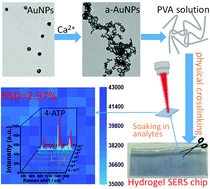Hybridizing aggregated gold nanoparticles with a hydrogel to prepare a flexible SERS chip for detecting organophosphorus pesticides†
Abstract
Surface enhanced Raman scattering (SERS) is an ultrasensitive analytic technique. However, the application of SERS in quantitative analysis usually suffers from poor reliability due to the limitations of currently developed SERS substrates. In the present work, aggregated gold nanoparticles (a-AuNPs) fabricated by Ca2+-mediated assembly are dispersed in polyvinyl alcohol solution to prepare a novel hydrogel SERS chip through a physical crosslinking method. Taking advantage of the uniform distribution of SERS active a-AuNPs in the three-dimension hydrogel and the excellent barrier effect of hydrogel towards oxygen and macromolecules, the obtained hydrogel SERS chips show many outstanding advantages including high sensitivity, good repeatability, long-term stability, and a robust anti-interference ability. These advantages enable hydrogel SERS chips to be used to quantitatively analyse some complex samples without complex sample preprocessing. As a model, the hydrogel SERS chips are used for the detection of triazophos and phosmet in orange samples. The good recoveries suggest good applicability of the hydrogel SERS chips in food safety detection. This work provides a reliable and convenient platform for the quick detection and on-site monitoring of chemical contaminants and would promote greatly the performance of SERS techniques in quantitative analysis.



 Please wait while we load your content...
Please wait while we load your content...